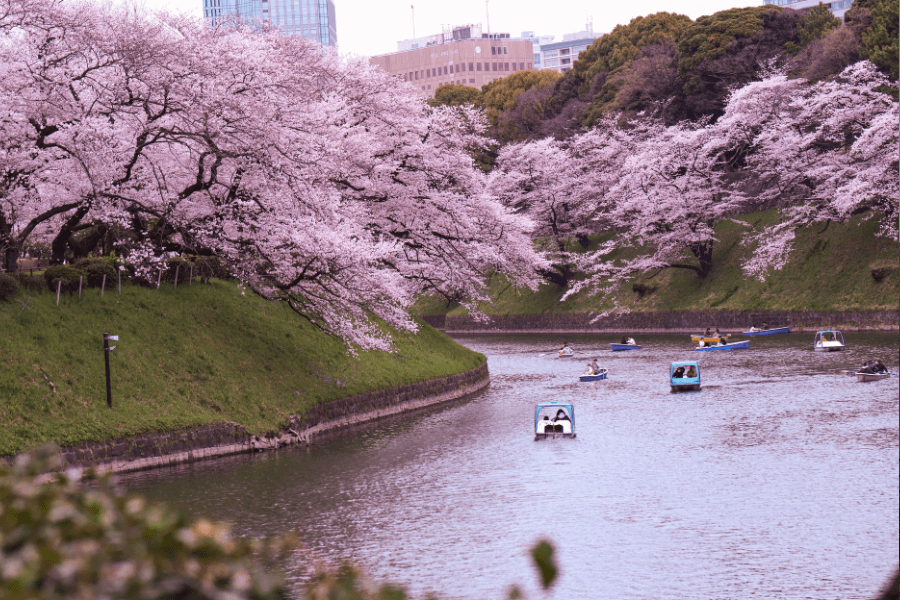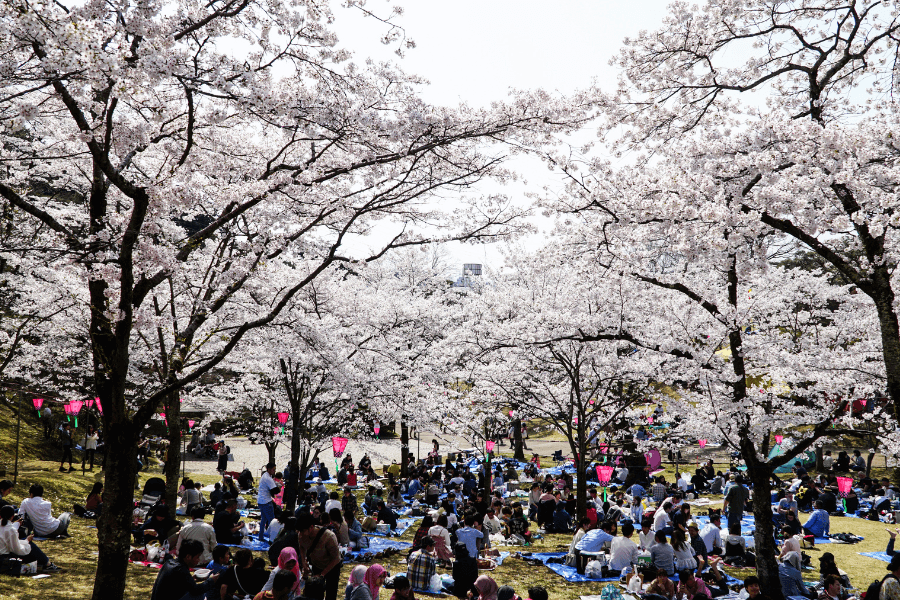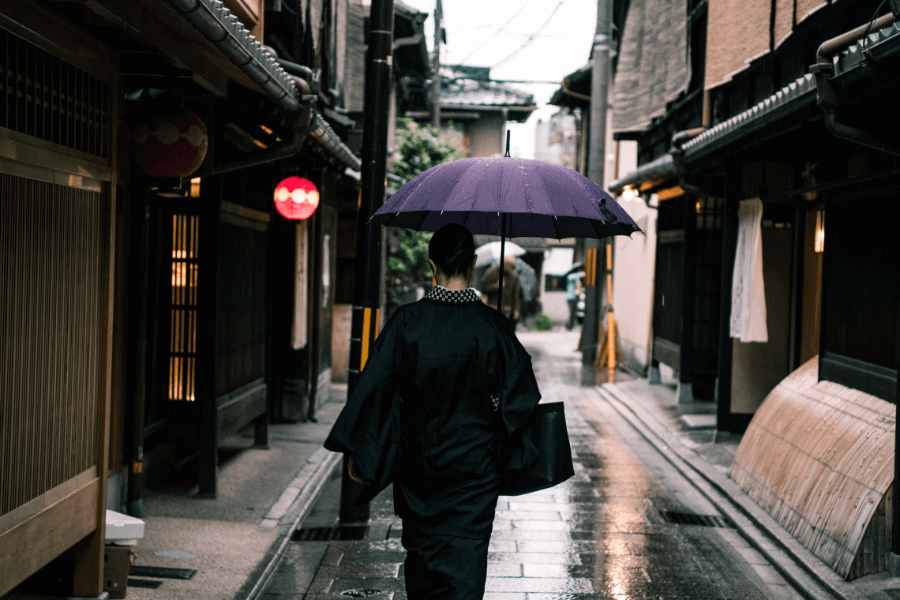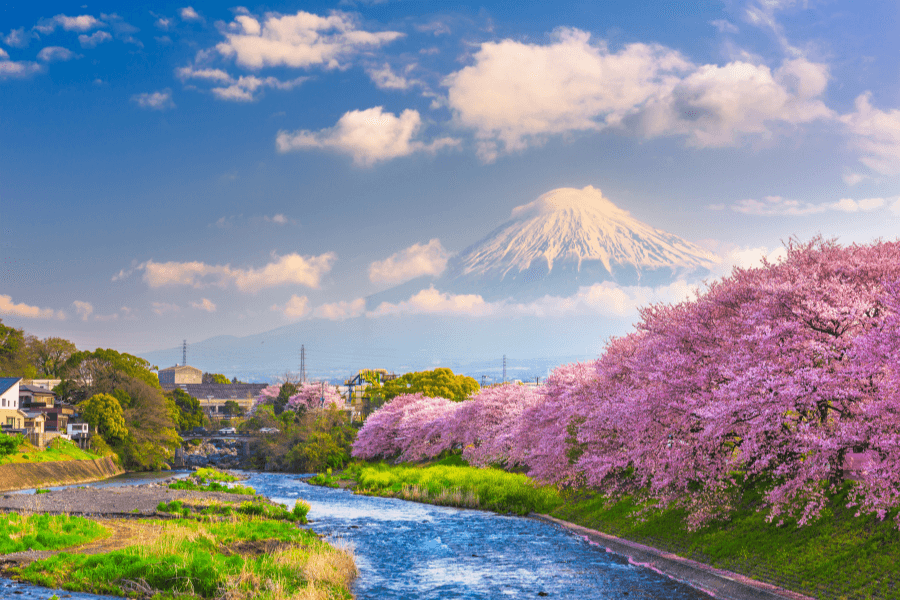Nestled between the pages of this guide is the key to unlock Japan’s seasonal secrets.
From cherry blossoms in spring to vibrant autumn foliage, trip to Japan promises an immersive experience into Japan’s cyclical beauty.
Japan is a dream destination for many. Japan, filled with diverse attractions, rich cultural encounters, and breathtaking landscapes, captivates travelers no matter the season. However, the important question is, “What is the best time to visit Japan?” The response is far from universal because it’s closely tied to individual preferences.
For some, the allure of cherry blossoms dancing in the spring breeze might be the best time to go to Japan. For others, the festive air during traditional Japanese events, the ethereal beauty of autumn foliage, or the desire for a budget-friendly trip might tip the scales. Families might prioritize school holidays, ensuring their children can soak in Japan’s magnificence without academic interruptions. Then there are those who seek the simple pleasure of comfortably cool weather.
As we delve into each season’s unique charm, remember: the best time to travel to Japan for one might not be the best for another. Read on to tailor your dream itinerary, be it spring’s rejuvenation, summer’s vivacity, autumn’s serenity, winter’s mystique, or even the times you might want to skip for a more enjoyable experience.

Visiting Japan in the winter is nothing short of enchanting. The entire country transforms into a winter wonderland, from the pristine snow-laden landscapes of Hokkaido to the bustling streets of Tokyo adorned with shimmering lights.
One of the most captivating events during Japan winter season is the Sapporo Snow Festival held in Hokkaido. The festival showcases enormous, intricate ice sculptures that attract visitors from around the world. Skiing in the snow-covered mountains of Hokkaido remains one of my most cherished memories for many people who visit Japan during the winter. The powdery snow, the serene environment, and the thrill of descending the slopes are experiences one should not miss.
Another must-experience of winter in Japan is indulging in its seasonal foods. Warm up with a steaming bowl of ramen or treat yourself to ‘yaki imo’ – roasted sweet potatoes sold by vendors with wood-burning stoves in the back of their trucks.
One of my favorite winter spots is the historic village of Shirakawa-go, a UNESCO World Heritage site. It’s a picturesque village known for its traditional thatched-roof houses, which, when covered in snow, look even more beautiful. There’s nothing quite like walking through this village under a gentle snowfall, with the warm glow emanating from the houses and the tranquil silence surrounding you.
Japan during winter offers a blend of cultural festivities, exhilarating activities, and gastronomic delights that cater to every traveler’s desire. Whether you’re a snow enthusiast, a culture buff, or a foodie, Japan in winter promises memories that will last a lifetime.

While there are a lot of things you can do in Japan in winter, it has a couple of disadvantages too. If you’re hoping to visit Japan’s beautiful parks, gardens, or temples, you might find them less enjoyable or even inaccessible during the winter. Famous spots like Kyoto can be quite bleak and barren as most vegetation is dormant.
With the sun setting earlier, you’ll have fewer daylight hours to explore. This can make sightseeing or outdoor activities challenging, especially if you’re trying to fit multiple destinations in one day.
Winter in Japan brings some delicious seasonal foods like nabe (hot pot) and mochi, but certain fresh ingredients might not be available. If you’re eager to try Japan’s fresh fruits and vegetables, summer or fall might be a better choice.
If you are visiting places with a lot of snow, you should know that it can disrupt public transportation. Trains might be delayed, and in some cases, certain routes could be completely shut down. If you’re on a tight schedule, this can pose significant inconveniences.

Sakura carries deep cultural and aesthetic significance in Japanese culture, representing the transient nature of life with its short-lived but intense bloom. The country transforms into shades of soft pink, with petals delicately floating in the breeze, capturing the hearts of both locals and tourists alike.
For those seeking the quintessential cherry blossom experience, Ueno Park in Tokyo is an absolute must-visit. It buzzes with life as thousands gather to admire the breathtaking canopies of blossoms. In Kyoto, Maruyama Park is another sakura hotspot, where visitors can sit under ancient cherry trees and soak in the serene atmosphere. Further west, Hiroshima Peace Memorial Park, already poignant for its historical significance, is further accentuated by the beauty of blooming cherry trees, offering a unique blend of peace and reflection.
Japan spring season isn’t just about cherry blossoms. The season is also marked by vibrant spring festivals celebrating the new beginnings. From traditional dance performances to vibrant parades, every corner of Japan comes alive. Hanami picnics are another beloved spring tradition, where families and friends gather under cherry blossom trees, sharing food and laughter, embracing the season’s spirit.
The warmth of the Japanese people, the taste of homemade sakura mochi, and the entire cultural experience can make life long lasting memory, truly capturing the essence of Japan’s spring.

Perhaps the most glaring drawback of visiting Japan in the spring is the sheer volume of tourists. Popular cherry blossom viewing spots like Ueno Park in Tokyo or Kiyomizu Temple in Kyoto can be packed to the brim with visitors. Not only does this hinder the serene, tranquil experience many are seeking, but it can also make navigation and taking photographs a challenge.
Due to the influx of visitors, hotel and ryokan (traditional inn) prices can surge dramatically. Moreover, finding a place to stay without pre-booking well in advance can be nearly impossible in hotspots like Kyoto or Hiroshima.
While cherry blossoms are undoubtedly beautiful, their bloom is notoriously unpredictable. Depending on the weather, the blossoms might emerge earlier or later than usual. If you’ve scheduled your trip for a specific week hoping to catch them in full bloom, there’s a chance you might miss them entirely.
With the surge in sakura (cherry blossom) tourism, there has been an inevitable rise in commercial activities centered around it. This means more souvenir stalls, themed merchandise, and pop-up eateries. While some might enjoy this, others feel it detracts from the authentic experience of hanami (flower viewing).
Spring in Japan can be quite fickle. While there might be warm, sunny days perfect for picnicking under the sakura trees, there can also be rainy, chilly days that make outdoor activities less enjoyable.

Ah, summer in Japan—a season that truly brings the country to life in a vibrant explosion of color, sound, and taste. As the sun warms the archipelago, streets and parks are bathed in the fervor of countless matsuri (festivals). From the bustling streets of Tokyo to the quaint villages in Kyushu, the skies light up with awe-inspiring fireworks displays that captivate both locals and tourists. If you’ve never witnessed a Japanese hanabi (firework) display, prepare for a breathtaking experience that goes beyond mere visual splendor.
The coastal regions beckon with promises of pristine waters and sun-soaked shores. Okinawa, often referred to as Japan’s tropical paradise, boasts beaches that could rival any in the Caribbean with their clear azure waters and golden sands. But if the sweltering heat of the city becomes too much, the cooler climes of the Japanese Alps offer a serene escape. Nestled among these towering peaks, you’ll find idyllic summer retreats that are perfect for hiking, relaxation, and reflection.
No Japanese summer experience is complete without indulging in the country’s traditional summer delights. Wander the streets and you’ll find stalls selling kakigori, a shaved ice dessert flavored with sweet syrups ranging from classic melon to the more adventurous matcha. And as evening approaches, locals don their vibrant yukatas—a lighter version of the kimono—for evening strolls or festival visits. Among the numerous summer festivals, the Obon stands out. Rooted in Buddhist traditions, this festival honors the spirits of ancestors, and communities across Japan celebrate with dances, lanterns, and feasts.
One of my most cherished summer memories in Japan was during a trip to the northern regions. After attending the famed Akita Kanto Festival, a celebration featuring tall bamboo poles adorned with paper lanterns, I escaped the city’s heat and retreated to a secluded mountain onsen in Tohoku. As I soaked in the rejuvenating waters, surrounded by the lush greenery and distant sounds of a murmuring stream, the essence of a Japanese summer truly dawned on me. It’s a blend of excitement and serenity, tradition and modernity, and above all, a profound appreciation for the fleeting beauty of the season. Whether you’re gazing at exploding fireworks, savoring a cool bite of kakigori, or finding solace in the mountains, a summer trip to Japan promises memories that will last a lifetime.

The most significant drawback of visiting Japan in summer is the intense heat coupled with high humidity. Cities like Tokyo, Osaka, and Kyoto can see temperatures rising above 35°C (95°F). The humidity, often above 80%, can make it feel even hotter. For many, this combination can be uncomfortable and even dangerous if not prepared.
Summer in Japan aligns with the school holiday season in many countries, leading to a surge in tourists. Popular destinations can be crowded, and you might find yourself waiting in long lines, whether it’s for a temple visit in Kyoto or a theme park ride in Tokyo.
June and July mark the tsuyu, or rainy season in Japan. While the rain provides relief from the heat, it can disrupt travel plans. Tourists might find outdoor activities, particularly in nature spots, compromised due to the wet conditions.
To combat the heat, air conditioning units run at full blast in almost all indoor spaces. While this might sound appealing, the extreme temperature differences can be tough on your body, leading to colds or other health issues.
While summer festivals, or matsuri, are a highlight, they also bring in even larger crowds. If you’re not a fan of congested spaces, navigating through the festive streets can be a challenge.

Autumn in Japan is synonymous with the mesmerizing spectacle of koyo or the viewing of autumn leaves. That’s why many people consider it one of the best times to visit Japan. As the season changes, entire landscapes transform into breathtaking canvases of reds, golds, and yellows. Two spots particularly stand out in their autumnal brilliance: Kyoto’s Kiyomizu Temple and Tokyo’s Meiji Shrine. As you tread the stone pathways of Kiyomizu or walk beneath the towering trees of Meiji Shrine, you’re treated to a natural symphony of rustling leaves and a visual feast of color.
The beauty of Japanese autumn is not limited to just its foliage. The season brings with it distinct culinary delights. Imagine warming your hands and soul with a freshly roasted sweet potato, its natural sweetness enhanced by the crisp autumn air. As temperatures dip, the onsen beckons. There’s something deeply therapeutic about soaking in a hot spring, surrounded by nature’s beauty in full autumn display.
Your Japan fall itinerary should definitely include a series of festivals and cultural events. Towns and cities come alive with celebrations, acknowledging the fleeting beauty of the season and the gifts it brings. From harvest festivals to parades and dances, autumn in Japan is a culturally rich and vibrant time.
If you’re considering visiting during this season, I can promise you a journey filled with natural wonders and cultural delights.

Autumn is one of Japan’s most popular tourist seasons, which means you’ll be sharing attractions with hordes of people. Locations famous for their fall foliage like Kyoto’s temples and Tokyo’s parks can be overwhelmingly packed. This can result in longer waiting times and higher prices for accommodations.
As the demand for accommodations, tours, and other services rises, so do the prices. You might find that prices for hotels and ryokans (traditional Japanese inns) are significantly higher during the peak fall season, particularly in areas renowned for their autumn foliage.
While autumn often brings milder temperatures, it can also be quite unpredictable. Rain can be a regular occurrence, and typhoons are not uncommon during the early autumn months. This can disrupt travel plans, particularly if you are hoping to spend a lot of time outdoors.
Finally, the days become shorter during the autumn months, which means less daylight for sightseeing. If you’re hoping to make the most out of your days, this can be a significant drawback.

Determining the “worst” time to visit Japan is largely subjective and hinges on what an individual traveler might find less than ideal for their journey.
One significant factor many consider is the weather. Japan’s typhoon season, running from July to October with its peak in August and September, can be quite intimidating. These intense storms often lead to disrupted travel plans, with the possibility of flight cancellations and damage in the hardest-hit areas. Closely following this period is the rainy season, known as “Tsuyu.” Starting in early June and lasting for about a month, the nation is enveloped in a consistent drizzle. Although some find a certain romantic charm in the rain-soaked landscapes, those hoping for more outdoor activities might be left disappointed.
Another crucial element travelers often mull over is the crowd size. Japan, rich in its cultural festivals and natural beauty, can get incredibly packed at certain times of the year. The Golden Week, which occurs from late April to early May, is notorious for drawing both locals and tourists to various hotspots. Transportation modes are crowded, accommodation prices soar, and the general hustle and bustle can be overwhelming for some. Similarly, the cherry blossom season, spanning from late March to early April, witnesses an influx of visitors eager to catch a glimpse of the ethereal sakura blooms. While the scenery is undeniably captivating, the throngs of people at popular viewing spots can be a deterrent for some.
Budgetary constraints are also a significant concern for many travelers. Peak tourist seasons like the Golden Week, cherry blossom season, and Japan’s winter holidays, especially around New Year’s, can be tough on the wallet. Accommodations, travel, and even certain attractions might see a substantial markup in prices.
There are other nuanced factors to consider. For instance, some of Japan’s renowned attractions, like theme parks and certain museums, might shut down for periodic maintenance. It’s a bitter disappointment for travelers who arrive only to find their desired destination closed. Moreover, the summer months of mid-July to August present their own challenge. With soaring temperatures combined with high humidity levels, those unaccustomed to such conditions might find it less than comfortable.
In essence, the “worst” time to visit Japan varies for each individual. What might be a dealbreaker for one could be an enticing factor for another. To make the most of a trip to this fascinating nation, aligning travel plans with personal preferences is key. Research, awareness of seasonal variations, and some flexibility can ensure a memorable Japanese experience.

In Japan, every season paints a distinct picture. The blossoming sakuras of spring, the vibrant matsuri festivals of summer, the breathtaking koyo (autumn leaves) displays in the fall, and the serene snowscapes of winter; each presents a unique allure.
The best time of year to visit Japan hinges on what you seek from your journey. Whether it’s the temperate embrace of spring, the cultural immersion of summer, the visual feast of autumn, or the tranquil chill of winter, Japan has something for every traveler’s palate.
As with any travel destination, there are periods where crowds and weather might detract from the experience. It’s essential to weigh these factors against your interests to determine your ideal timeframe.
When you pack your bags for Japan trip, remember: it’s not just about when you go, but why you’re going. Safe travels and let Japan’s seasons guide your adventure!